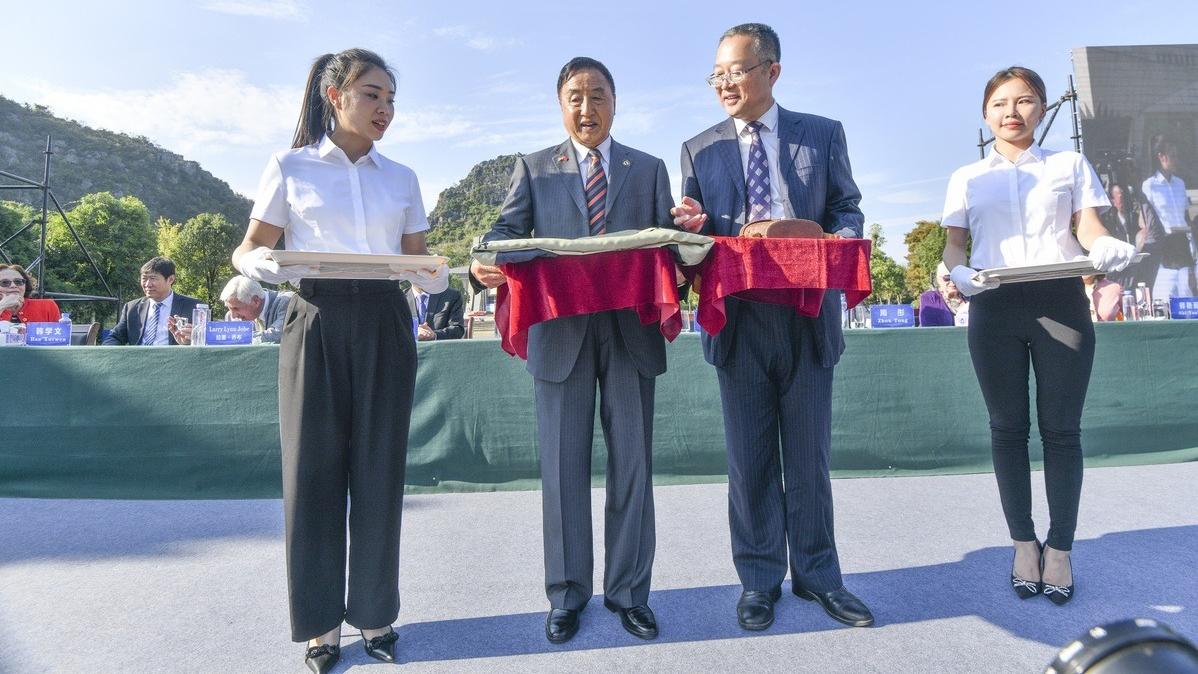 The Flying Tigers Historical Association donated 80 relics to the Relic Park of Yangtang Airport for Flying Tigers on Tuesday in Guilin, Guangxi Zhuang autonomous region. (WANG ZHANFEI / FOR CHINA DAILY)
The Flying Tigers Historical Association donated 80 relics to the Relic Park of Yangtang Airport for Flying Tigers on Tuesday in Guilin, Guangxi Zhuang autonomous region. (WANG ZHANFEI / FOR CHINA DAILY)
Historical relics from American General Claire Lee Chennault, commander of the Flying Tigers — who assisted China in its fight against Japan during World War II, were donated on Tuesday to the Relic Park of Yangtang Airport for Flying Tigers in Guilin, Guangxi Zhuang autonomous region.
"We must remember the past in forging ahead to a better future," said Larry Jobe, president of the Flying Tigers Historical Organization as he expressed a desire to preserve the legacy.
Since its establishment, the Flying Tigers Historical Association has been passing down the legacy of what happened during the war and contributing to friendly interactions between the Chinese and American people
The organization donated 80 items associated with the American Volunteer Group, nicknamed the Flying Tigers. Based at Yangtang Airport in Guilin, they fought alongside Chinese residents and wrote a remarkable chapter in the history of the Chinese resistance against the Japanese invasion.
READ MORE: Flying Tigers veterans saluted for 'profound friendship'
In 2015, the Guilin government built the park to remember history and promote friendship between China and the United States.
"Collecting artifacts from this time period is getting harder every day as veterans pass on. Their mementos and treasures are often overlooked by the younger generation. Museums like the park in Guilin can help keep these memories alive," Jobe said.
Since its establishment, the Flying Tigers Historical Association has been passing down the legacy of what happened during the war and contributing to friendly interactions between the Chinese and American people.
Cynthia Louise Chennault, the daughter of General Chennault, brought a telescope used by her father in Guilin, along with the Phoenix embroidered banner, which is dedicated to the air unit.
"I found this telescope in my mother's drawer by chance — and what a coincidence. This is the one I saw in a photo of my father in Guilin. So I decided to bring it here to enrich the collection of the museum and hope that more people will visit it and learn the history, especially the young generation," she said.
Liao Pinhu, vice-governor of the region, said the legacy of the Flying Tigers continues to be passed down generation after generation, both in China and the US. To remind the younger generation of this precious history of aid and mutual friendship, Guangxi has been renovating many relics.
"We built the park in Guilin and held an exhibition for the US Flying Tigers at the Liuzhou Military Museum. We continue to check on veterans and collect historical materials to extend and expand the friendship we established during our side-by-side fight," Liao said.
Currently in the park, 255 items are donated by the historical association, including military uniforms, medals and old photographs.
The memorial hall of the park uses audio-visual exhibition display technology that combines pictures, cultural relics and models to tell the story of the Flying Tigers in Guilin.
 The Flying Tigers Historical Association donated 80 relics to the Relic Park of Yangtang Airport for Flying Tigers on Tuesday in Guilin, Guangxi Zhuang autonomous region. (WANG ZHANFEI / FOR CHINA DAILY)
The Flying Tigers Historical Association donated 80 relics to the Relic Park of Yangtang Airport for Flying Tigers on Tuesday in Guilin, Guangxi Zhuang autonomous region. (WANG ZHANFEI / FOR CHINA DAILY)
In the aircraft hall, the last C-47 transport plane that flew over the famed "hump route" is housed. It was purchased from Australia by the organization.
READ MORE: Flying Tigers honored for support of China in WWII
According to the local government, the park attracts around 100,000 visitors each year. Nearly 100 veterans of the Flying Tigers and their families and friends from the United States came to pay tribute at the donation ceremony on Tuesday.
The park has become an important place to review history and remember the symbol of friendship between the people of China and the United States.
Ma Kuanchi, vice-president of the FTHO, said he will work to expand the park's collection further and facilitate people-to-people exchanges between China and the US — particularly among young people.


